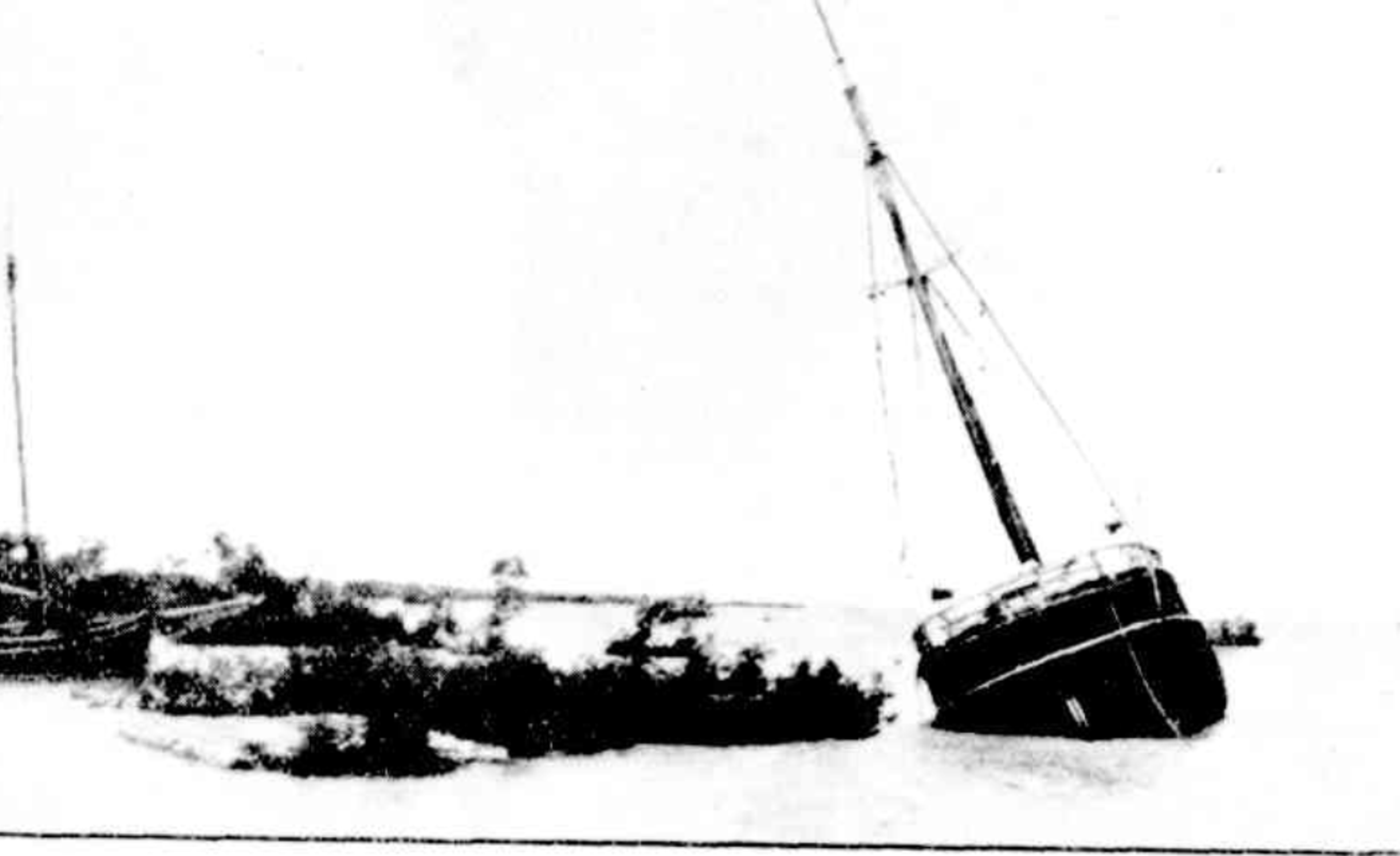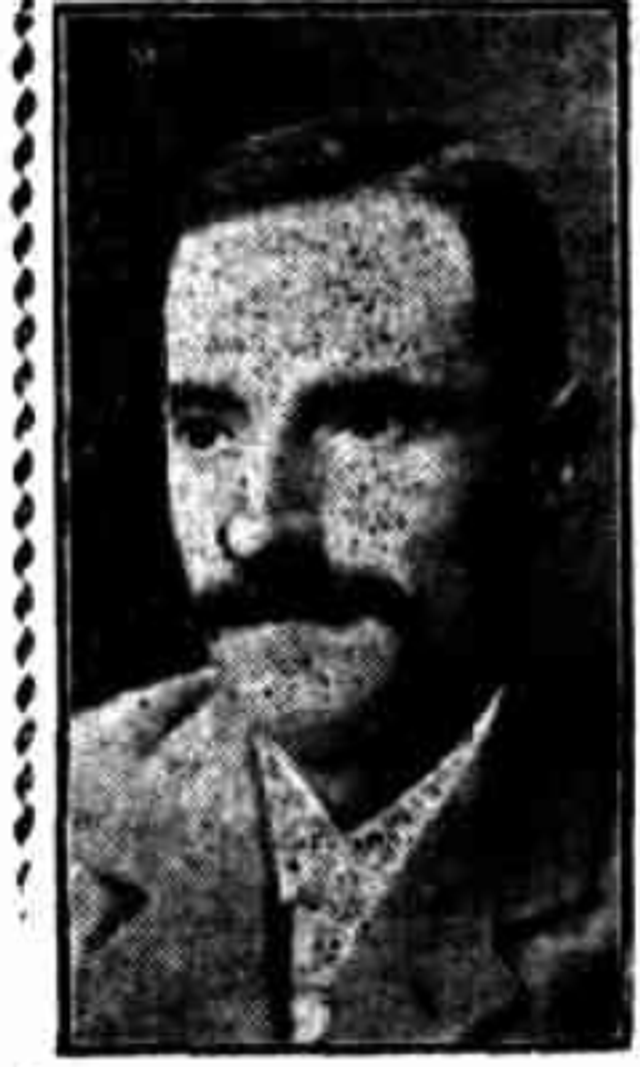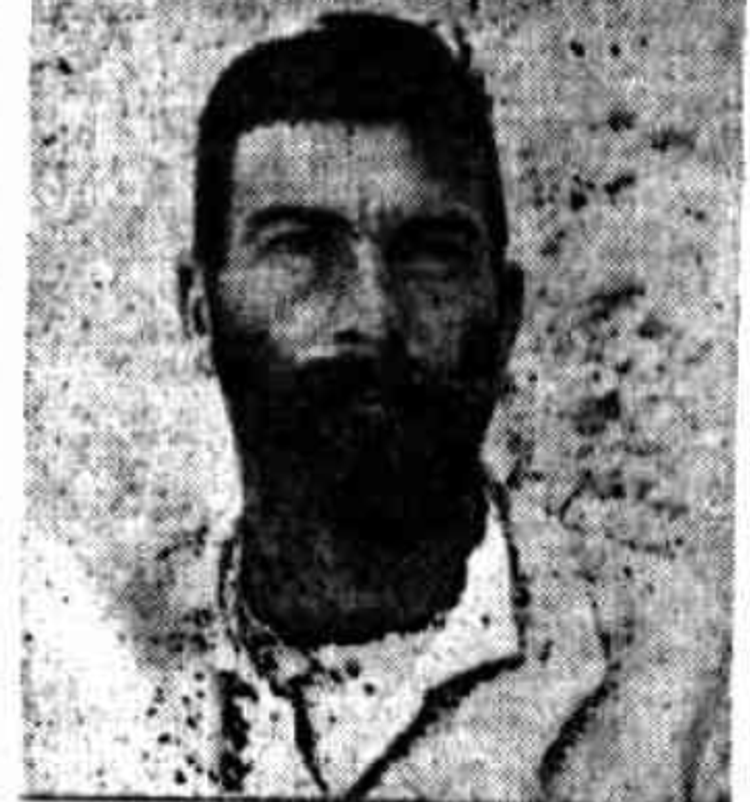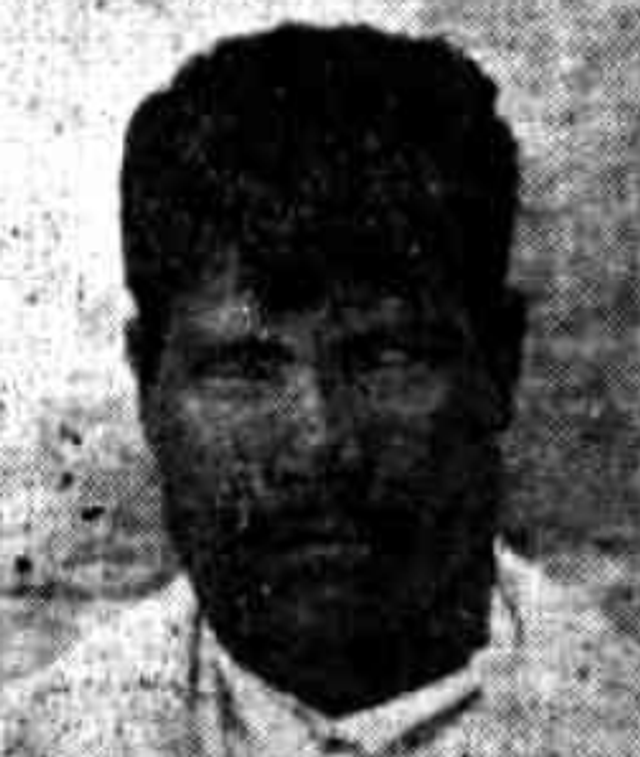The Liebglid Pearl Murder
Mark Liebglid, murdered 30 August 1905
Charles Hagen, hung for murder on 14 December 1905
Pablo Marquex, hung for murder on 14 December 1905
Simeon Espada, hung for murder on 14 December 1905
Castilla Toledo, drowned in cyclone on 8 December 1908
Sulu, died from heart attack in 1910
Gomez, died by suicide, 1911
Abrahaim Vahl Davis, lost in cyclone on 20 March 1912

Abandoned Schooner Mist at High Tide

Mark Liebglid

Charles Hagen

Pablo Marquez

Simeon Espada
Master and part owner of Cleopatra Gustav Ullbricht arrived in Broome for his first pearling season. As luck would have it, on his very first trip, his Swiss diver Silber Gula brought up a large pearl. Cleopatra’s shell opener and tender Augustine found the pearl in Silber’s shell. Gustav and Silber rowed across to the schooner Alto, where Captain Franck had scales to weight the pearl. Its weight of 65 grains, and roseate tint made it a valuable pearl indeed.
Carl Lilly, master of the Toniko Toko rowed across to see the prize, with his diver Victor. The usual way to celebrate a valuable find was to drink with nearby masters and their divers. The pearl was placed in a matchbox (the most common way to store them) with a smaller pearl, and the box was kept in Silber’s coat pocket. When the bottles were empty and the crews had gone back to their boats, the pearls were missing.
Victor had carelessly left a written agreement where others could find it when the boats were searched. He was identified as the thief who had plotted with the tender/shell opener Augustine. The agreement was witnessed by Sebastian, another crew member aboard Cleopatra. The matter went to court and Victor claimed the pearls had been stolen from him before he reached port. A search of Toniko Toko did not reveal the pearl’s whereabouts, although there was a rumour that Victor still had the pearl hidden away. Its seems a diver called Castilla Toledo on the Toniko Toko, hid the matchbox containing the pearl in a coil of rope.
Of course the story of the missing pearl spread through the drinking and gambling houses in Broome. It came to the attention of Mark Liebglid, a Jewish commercial traveller who worked for Freedman & Co. and Falk & Co. in Broome. Liebglid was prone to flashing a large money clip and wore a large gold signet ring. He made loans to crewmen at times. Liebglid also bought pearls for cash, and was known to buy “snide” pearls; the questionable provenance of a pearl was not a deterrence to purchase.
Liebglid travelled the world selling and purchasing for his employers. Shipping intelligence reported in the newspapers of the late 1800s and 1900s show Liebglid travelled to London regularly, buying and selling. He had a base in Broome for business he conducted in the pearl seasons.
Simeon Espada was a 28 year old Malay. He had a reputation for violence against men and women, fighting in hotels and assaulting the girls at Japanese brothels. He had a criminal history, and had previously served a prison sentence.
Norwegian Charles Hagen was thirty years of age. He had been in Broome for 10 years. He leased a billiard saloon in Carnarvon Street, and employed a billiard marker called Justin Ferrel, known as “Porterico”. Hagen wore white trousers and a white jacket. There seems to be a consensus that Hagen had experience with black market pearls. It was also known he was in considerable debt, struggling to pay the lease on the billiard room. He was heard making comments that his wife was demanding money from him.
Pablo Marquez was 26 years old, and had worked at sea all over the world, had saved and owned property. He had a reputation for violence and was known to police. He had a barber’s shop three or four doors away from the billiard room, and he lived behind the saloon. Liebglid lived next door to Marquez’s shop. Marquez also worked on Toniko Toko.
Simeon Espada had also worked across the globe, but had gambled his earnings. He signed on as the cook on Toniko Toko a few days before the murder, and lived aboard. Espada was also known to police as a violent and untrustworthy man. Reportedly he saw Toledo hide the pearl, and took it for himself.
Hagen, Marquez and Espada came up with a plan to rob Liebglid of his money. They deviously invited Liebglid to look at the missing pearl, out of sight at night aboard the abandoned lugger Mist.
Before 9pm on Wednesday 30 August 1905, Liebglid took a cheque to Gasokichi Murakami, an esteemed Japanese store manager, and left with cash. At 9pm he asked his friend Wales and Edward Clais, labourer and frequent customer, to look after his billiard saloon while he went to a nearby camp to get £23 he owed to Wales. Constable Trebilcock spoke to Marquez in the lane as he headed to Carnarvon Street at 10pm.
By arrangement, Liebglid met Hagen, Espada and Marquez at the dinghy from Toniko Toko which Espada had used to get from his workboat to the beach. They rowed out to the abandoned schooner Mist and went aboard where Liebglid expected to see a large pearl. Espada was wearing a slingshot he made for a belt, and he carried a heavy rowlock. He went to the galley and brought up a handkerchief. Instead of finding a pearl, Liebglid saw a glass lemonade bottle-stopper (like a marble). Espada hit the back of Liebglid’s head with the sling shot, causing him to fall overboard into eight feet (4.5 metres) of water.
Liebglid could not swim. He clung to the side of the dinghy, and began to shout for help. Espada jumped into the sea and tried to drown Liebglid, although he was almost dead because Hagen and Marquez jumped into the dinghy and struck his head repeatedly with the dinghy’s oars.
Hagen tried to drag him into the dinghy so he could rifle through his pockets. He was heavy and already dying when Espada struck Liebglid’s hands with the slingshot to make him let go of the dinghy. Hagen swung a final punch to Liebglid’s face, getting blood on his hand, which he wiped on his trousers. Liebglid sank below the surface.
Constable Trebilcock, patrolling his beat, heard cries of “Help, police! Murder!” coming from the water front near the abandoned schooner Mist. He ran to the waterfront, where Allan Charles Neall, the licensee of the Pearlers Rest Hotel, and others had also heard the cries. They called out, “What’s happening? Who’s there?”, but there was no answer. It was a dark night, and nothing could be seen, but the men heard a dinghy rowing towards the Rose. Constable Trebilcock called out when the rowing stopped, however there was no reply. He took Yee Ah Chun’s dinghy and rowed to the Rose. He found a man fully clothed, and one in pyjamas, but nothing to arouse his suspicion, except there were two dinghies tied to the schooner.
The three killers abandoned the robbery, thinking that the cries for help may have been heard. They rowed quickly to the mangroves and went ashore, leaving the merchant to drown. They agreed to remain silent and returned to their respective homes.
The next morning at 9.30am, Nakashimah Kago, one of Captain Mils crewmen, reported to Councillors Hawke and Nick that a dead body had been found floating 40 yards (36.5 metres) from the Mist. The councillors immediately went to see, and pulled the body from the water. Constable Trebilcock was present when the body was taken from the water, and identified as Mark Liebglid, although the injuries to his head were significant.
Constable Trebilcock and Constable Nelson took the body to the morgue where Doctor Graham Blick, the coroner, commenced an autopsy. Sergeant Byrne and Detective Harry Mann were called to investigate. Their first port of call was Liebglid’s accommodation, which had been ransacked and his valuable stock of gems, gold, jewellery and money were gone. Liebglid’s loans meant he had valuable assets he was holding as security. Hagen and Marquez were responsible for the robbery. Marquez sold his share of the gold to a Japanese trader, which placed him in the spotlight for the robbery, especially as he owed £1000 of gambling debt.
Clues came from questioning neighbours, crewmen and storekeepers. Anthony Pedro, a fisherman, claimed to have seen Espada making a slingshot a week before the murder. Andreas Colino, tender on Toniko Toko (the boat Espada worked on) stated Espada took the boat’s dinghy and did not return to the boat until midnight. Soon Lee, laundryman, said he received a white coat and trousers with stains on them from Hagen on 4 September.
The coroner provided evidence and he stated Liebglid would have died from his head injuries if he had not been drowned. He had sustained 10 significant head injuries, skull fractures, wounds that were deep enough to expose bone, and broken fingers. He died with £450 in notes, and £1. 4s. 6d. in his pockets and his jewellery still on his body.
Espada, Marquez and then Hagen were suspected. Espada was heard threatening the others to remain silent. His discussion of the murder in the Pearlers Rest was overheard, and reported. Marquez was a suspect, as he had previously told people he had murdered a man in Hong Kong and had not been caught. All three gave statements which incriminated the other two before Resident Magistrate Warton, Sergeant Byrne and Father Russell, the Catholic priest. Espada’s statement was helped by Patrick Percy, hotelier, because Percy spoke Tagalog, Espada’s native tongue. Marquez provided three statements, finally confessing to the murder, and turning King’s council.
The arrested men were taken to Fremantle to await trial by the Supreme Court, the case commenced with the prosecution evidence on 7 November 1905. There were 26 witnesses in all, 19 for the prosecution and seven for the defence. Justice Burnside presided, with a jury of three. The prosecutor was Mr A.E. Barker, assisted by Mr G.T. Wood. Hagen was represented by Mr R.S. Haynes, K.C. assisted Mr A.S. Canning. Espada was represented by Mr C. Penny and Marquez’s defence lawyer was Mr William M. Purkiss. Each lawyer attempted to point the blame for the murder away from their client. On Saturday 11 November the jury were finally instructed to retire for deliberation. They returned to the court after five hours. All three men were found guilty of murder, motivated by robbery. All three received the death penalty. The verdict was not published until 14 November.
Hagen was executed at 8am on 14 December. He had been permitted to give a press interview from his prison cell, and for 20 minutes he claimed he was framed and police had incriminated him purposefully. He repeated his claim of innocence at the scaffold. Reverend O'Halloran encouraged him to stop after a 15 minute garbled protest. Unused to hanging Europeans, the executioner broke down and wept.
At 9am Espada and Marquez were executed together. Reverend Father Cox accompanied them to the scaffold. Incredibly, they argued violently in their native tongue while waiting for the executioner, and had to be restrained. Before the lever could be pulled to drop the platform, Espada freed one of his hands and gripped the halter to prevent him dropping.
Chief Warden Webster stepped forward to restrain Espada’s grip on the halter, just as the trapdoor opened. He fell headlong down the 12 feet (3.6 metre) drop with the two condemned men. He was taken to the prison hospital with a serious head injury, and body injuries that required 12 months of recuperation. He returned to duty on 19 November 1907.
In April 1906 Probate and Administration started to dismantle Liebglid’s estate. He died intestate. Moss and Barsden, Solicitors for the Administrator advertised in newspapers for the widow and any family to come forward to make a claim.to the estate, or the assets would be awarded to Freedman & Co.
The cost of the murder trial was £3000, and in 1909 planning commenced for the establishment of a district registry of the Supreme Court, with quarterly visits by Justices and legal representatives, both to save money and to ensure a more equitable court system for those who could not afford to travel to Perth for justice.
Detective Inspector Harry Mann became one of the best-known police in Western Australia, until his retirement in 1919. He was one of only two men awarded the King’s Medal in 1912 for detective work. He retired to his farm at Nungarin in 1919.
On 23 December 1905 Toledo was sentenced to three years imprisonment for receiving a large and valuable pearl. He had reported the theft to police, accusing Marquez, Hagen and Espada, saying the pearl was being stolen from him on the Toniko Toko before he reached the shore. After he served his sentence, he returned to Broome. He had figured out that Sulu had the pearl, and threatened to kill him. He did not get the opportunity. He was drowned along with so many other pearlers on 8 December 1910, in a cyclone off Eighty Mile Beach.
No one knows where the roseate pearl really went, although various stories circulated. Pearls were hidden regularly in cakes of soap, in book bindings, in elaborate hair styles and insides shoes. It seems that Marquez may have left the pearl with Sulu, an ageing Manilaman who lived at the Rio Janeiro Guesthouse in Chinatown. The guesthouse was searched, but the pearl was not found. After Toledo was drowned, Sulu sold the pearl and returned home. Ironically, he died from a heart attack while disembarking from the boat at Manila.
Sulu had sold the pearl to a Filipino called Gomez, the owner of the guesthouse. Gomez had depression and was in a sorry state. The pearl was stolen and not long after, having lost his savings and the pearl, Gomez took his own life.
It is not clear who stole the pearl form Gomez, but it was sold to Abrahaim Vahl Davis, the best-known and fairest pearl buyer who travelled to Broome for the pearling seasons. Davis was in Port Hedland on 19 March, returning to Broome for the 1912 season aboard the steamship Koombana. Purser Hedley Harris kept £2500 in the ship’s safe for Davis, who bought and sold pearls in the ports on the way. The pearl had been cleaned by Thomas Bastion Ellies, known as “T.B.”, the most respected pearl cleaner on the West Australian coast. If it is true that Davis purchased the pearl in Port Hedland on 19 March 1912, it was lost forever because the next the Koombana was struck by a cyclone. Neither the ship, her crew, her passengers, or the pearl have ever been found.
